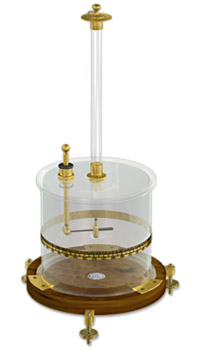Around the time that Coulomb gave Coulomb's law, how did people measure electric charge?
1 Answer
People did not. They generated and stored static electricity, but measuring it, other than by how strong the electic shock felt, was not yet done. Coulomb was the one who invented a way to do it in 1785. For this he used a device called torsion balance. John Michell used it earlier to measure gravity, but Coulomb re-invented the idea, and made it famous. Maglab.org has a picture and a description of how it worked:
"A narrow glass tube extends through the top of the glass case. At the top of the tube is a metal sphere, from which the needle hangs by the thread. A small metal sphere is at one end of the needle, which can swing freely due to its suspended state. Protruding through the top of the glass case is also a metal rod with metal spheres at both ends (one inside the case, one outside).
To use the torsion balance, Coulomb would hold an object near the metal sphere at the upper end of the metal rod. Any charge held by the object being studied would transfer to the metal sphere, then travel along the rod to the sphere at the other end. There the charge could affect the needle suspended in the case, which in its resting state touched the rod's lower sphere. So any charge in that sphere passed to the needle’s sphere. Once the rod’s sphere and the needle’s sphere both became similarly charged, they repelled one another. The repulsion caused the needle to move and the thread holding it to twist.
The twisting action is called torsion, hence the name of the instrument. To determine how much torsion occurred, Coulomb consulted a small scale marked in degrees near the upper end of the narrow glass tube. A second scale encircling the glass case itself allowed him to determine how far the needle moved. As Coulomb realized, the greater the charge, the greater the torsion and displacement he observed."
An additional question from the comments is how Coulomb established proportionality of the electric force to the charges. One could do it by doubling the charges and measuring what happens to the force, but the answer is... Coulomb did not. Falconer gives a good historical account in Charles Augustin Coulomb and the Fundamental Law of Electrostatics, where she writes:
"The second memoir (1787), on the attraction between dissimilarly charged bodies, shows Coulomb’s newtonian programme. It is the first to state explicitly that the force was proportional to the product of the ‘electric masses’ of the two bodies, a proposition that Coulomb frequently asserted but never attempted to demonstrate. Nor did he ever define a unit electric charge, relying on relative electric ‘masses’ or ‘densities’. Throughout, his treatment depends on the unstated assumption that electric mass is localized and analogous to gravitational mass..."
-
$\begingroup$ If he measured electrical charge by Coulomb's law, how did he conjecture such a law? $\endgroup$ Commented Nov 29, 2018 at 21:02
-
$\begingroup$ @LinearGuy He didn't, he measured effects of the charge that had nothing to do with how the electric field falls with distance from it. As for conjectures, after Newton assuming that electricity and magnetism obeyed the inverse square law by analogy to gravity was in the air. Priestley conjectured it explicitly in 1766, so did Cavendish in 1771, see Is Coulomb's law the earliest mathematical formula describing electricity? The problem was to find an experimental way to verify it. $\endgroup$– ConifoldCommented Nov 29, 2018 at 21:08
-
$\begingroup$ Without reference to distance, Coulomb's law says that the force between two charges is proportional to their product. If there is not a measurement of these charges, how is their product measured? $\endgroup$ Commented Nov 29, 2018 at 21:18
-
$\begingroup$ @LinearGuy The charges can be measured by the torsion balance, the repulsion/attraction force can be measured independently, using springs, for example. $\endgroup$– ConifoldCommented Nov 29, 2018 at 21:21
-
$\begingroup$ Sorry, I stated my last question incorrectly: Once the force of two charges is measured, which is proportional to the product of two charges, how does one know what the individual charges are? The torsion balance gives an ordering of charges, but not any quantification, right? $\endgroup$ Commented Nov 29, 2018 at 21:28
